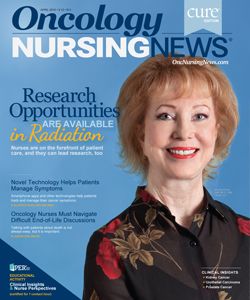Nurses Find Research Opportunities in Radiation Therapy
Nurses are already on the forefront of patient care, and they can lead research, too.

Deborah Watkins Bruner, PhD, FN, FAAN. - Photo credit Bailey Davidson
Patients with cancer often struggle as a result of radiation side effects. Dorothy Pierce, DNP, NP-C, CRN, CBCN, CLT, an advanced practice nurse in radiation oncology at Rutgers Cancer Institute of New Jersey in New Brunswick, understands this well.
Approximately 60% of patients with cancer benefit from radiation, which is used either on its own or in conjunction with chemotherapy.1 But along with its ability to kill cancer cells and shrink tumors, radiation therapy can cause treatment- related adverse events (AEs).
As patient advocates and educators, Pierce says, radiation oncology nurses have the unique opportunity to not only care for patients undergoing radiation therapy but also get involved in related research that improves patient care. With the field of radiation therapy rapidly growing, there is a need for more nursing innovation, according to Pierce. “Many nurse practitioners [NPs] are becoming involved in radiation oncology, and some are working as coinvestigators on quality-of-life studies with radiation oncologists,” Pierce says. “Because nurses are at the forefront of patient care, they can help improve practice guidelines.”
Last year, Pierce and her colleagues examined best practices for preventing vaginal stenosis, which causes abnormal tightening and shortening of the vagina. The condition is a common AE of pelvic radiation therapy or brachytherapy treatment for uterine, cervical, and vaginal cancers and affects about a third of women who undergo the procedure.2
Pierce conducted a phone survey in 6 New Jersey counties, talking with advanced practice nurses, registered nurses, and a brachytherapyfocused therapist, all of whom worked in radiation oncology programs. Healthcare practitioners were asked whether they counseled their patients on vaginal stenosis.
Survey results showed inconsistent practices in educating patients about the condition. Also, advanced practice nurses were underused in advising patients on best practices for managing and preventing vaginal stenosis, such as the use of vaginal dilators.
“[Although] not life-threatening, vaginal stenosis can result in long-term sexual dysfunction and painful vaginal examinations,” Pierce says. “Advance practice nurses are on the frontlines, helping to educate patients, pursue research opportunities, and implement quality improvement projects.”
Pierce began her own career as a primary radiation oncology nurse before going on to obtain her doctor of nursing practice (DNP) degree. “There are so many opportunities for nurses to make a difference in radiation therapy,” she says.
“Skin-care issues is an area where there are many inconsistencies in the guidelines, and [although] there are many creams that can help to relieve discomfort, they don’t prevent skin issues.”
Anxiety and depression are also common among patients who undergo radiation therapy, and this issue doesn’t receive enough attention, according to Pierce. “Patients often become depressed at the thought of their cancer returning,” she says. “Nurses play a critical role in identifying and managing each patient’s symptoms and ensuring they are linked to appropriate care.”
NURSES TAKE ON RESEARCH ROLES
Deborah Watkins Bruner, PhD, RN, FAAN, senior vice president of research at the Winship Cancer Institute at Emory University in Atlanta, Georgia, is considered a pioneer in oncology nursing research and cancer clinical trials. Her areas of focus include sexuality after cancer therapy, patient-reported outcomes, and symptom management for patients receiving radiation therapy.
“Nurse research should lead to or influence evidence-based patient care guidelines,” Bruner says. “There’s a plethora of data in radiation therapy research, but we need to have more nurses implementing the information in real time to help patients better manage symptoms.”
Bruner’s career path took a turn toward research when she was working as a clinical nurse specialist in gynecologic nursing. “I became frustrated at the lack of evidence for managing symptoms of gynecologic cancer,” Bruner says.
“Historically, there has been little attention on how radiation therapy and other treatments can affect a woman’s quality of life and sexual function after treatment for ovarian, cervical, and endometrial cancers.”
After earning 2 master’s degrees, 1 in oncology and 1 in nursing administration, Bruner decided to return to school to earn her PhD and pursue a career in research. She is the only nurse to lead a National Cancer Institute-sponsored National Clinical Trials Network cooperative group, the NRG Oncology National Community Oncology Program.
Many possibilities exist for nurses to move into radiation oncology research and be involved in writing policy- or evidence-based research, Bruner says. “There’s a tremendous opportunity for clinical oncology nurses, nurse practitioners, and nurse researchers to educate cancer patients, manage their patients’ care plan, and educate them on potential [adverse] effects,” Bruner says. “Nurses can follow a career path from staff nurse to DNP to PhD and play a significant role in the discovery and implementation of practice guidelines.”
PhDs are research-based, while DNP degrees are focused more on clinical practice.
NEW CANCER TREATMENTS REQUIRE RESEARCH ON SYMPTOM MANAGEMENT
Over the past 2 decades, radiation therapy has been increasingly used as a treatment option for patients with cancer, underscoring the need for oncology nurses to understand its impact on patients. Radiation therapy can be administered in many ways: by external beam, in which a machine delivers treatment; internally (brachytherapy), via sealed sources of radioactivity placed near or within the tumor; and, less commonly, by liquids taken orally or infused through a vein (systemic infusion).
Robotic systems such as CyberKnife, an advanced lightweight linear accelerator, mounted on a robotic arm, delivers an intense focused dose of radiation to the targeted tumor. Another treatment, stereotactic body radiation therapy, involves very high doses of radiation using several beams of various intensities aimed at different angles to precisely target the tumor.
“The changes in the treatment are driving oncology nursing care from supportive care for patients receiving radiation therapy to the primary care providers during radiation therapy,” says Jessica Liu, RN a clinical research nurse at City of Hope in Duarte, California.
Additionally, advancements in radiation therapy are leading to changes in how patient care is managed. For example, Liu says, a new, FDA-approved radioisotope IV radiation therapy, Lutathera, is used to treat gastroenteropancreatic neuroendocrine tumors. Until recently, patients with this condition had few treatment options.
“In addition to recent developments in therapeutic areas, radionuclide materials are also being studied in the diagnostic field,” Liu says.
Liu cites many studies that combine radionuclide with diagnostic scans to determine if physicians can visualize the disease beyond what current technologies provide. Several studies combine radioisotope and machine-targeted radiation therapies to manage certain cancers and explore more promising disease treatments.3,4
“Apart from the radionuclide approach, MRI [magnetic resonance imaging]—guided focused ultrasound is an existing technology used to treat certain cancers, and the results are encouraging,” Liu says. “This technology is being further developed to manage other types of cancers in different research phases.”
As radiation treatments evolve, the nurse’s role also expands to include both teaching and caregiving, showing patients how to effectively manage AEs. “Radiation exposure is a concern for many patients,” Liu says. “However, proper information and education before the therapy can help decrease patients’ anxiety.”
Many patients with cancer also undergo combined modality care, such as immunotherapy drugs used in conjunction with radiation therapy to treat advanced cancers. Nurses who work in radiation oncology will need to educate patients about the possible risks and symptoms associated with radioimmunotherapy, Bruner says.
“We still don’t know enough about the symptom profile of precision medicine and immunotherapies. With each new therapy, there’s a new symptom profile,” Bruner says. “In addition, patient adherence, financial toxicity, and drug toxicity are all issues of concern.”
Financial toxicity is a particular worry among older patients, Bruner says. Many must undergo 4 to 6 weeks of radiation therapy but have problems related to transportation and caregiving support, which can be obstacles to receiving care.
“There’s the reported [adverse] events such as skin issues and fatigue, combined with psychosocial factors such as depression and maintaining quality of life,” Bruner says. ““Nurses who work in this area look at issues that affect patients that go far beyond cancerous tumors.”
Editor’s note: In the print edition, the subject of the cover photo was incorrectly labeled as Dorothy Pierce. The correct subject of the photos is Deborah Watkins Bruner, PhD, FN, FAAN.
References
- National Cancer Institute. Radiation Therapy and You: Support for People With Cancer. Bethesda, Maryland. US Department of Health and Human Services. National Institutes of Health. 2016. https://www.cancer.gov/publications/patient-education/radiationttherapy.pdf
- Morris L, Do V, Chard J, Brand AH. Radiation-induced vaginal stenosis: current perspectives. International Journal of Women’s Health. 2017. doi: 10.2147/IJWH.S106796
- Velikyran I. Radionuclides for Imaging and Therapy in Oncology. Cancer Theranostics. 2014. doi.org/10.1016/B978-0-12-407722-5.00017-7
- Nitipir C, Niculae D, Orlov C, et. Al. Update on radionuclide therapy in oncology. Oncology Letters. 2017. doi: 10.3892/ol.2017.7141

Innovative Program Reduces Nurse Turnover and Fosters Development
Published: September 12th 2024 | Updated: September 12th 2024The US Oncology Network (The Network) has developed one of the most comprehensive programs in the nation to support the professional development and retention of new oncology nurses.


